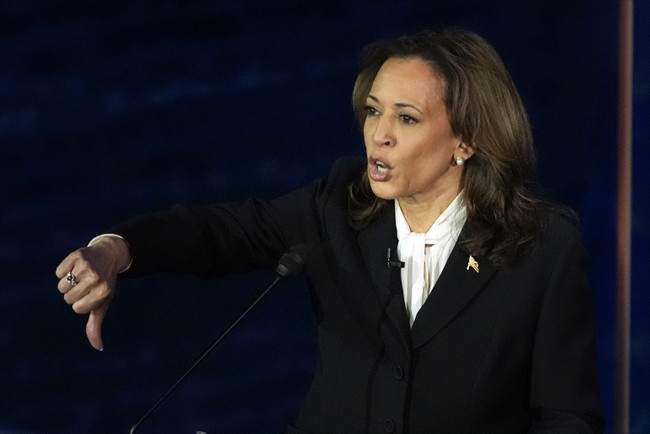We support our Publishers and Content Creators. You can view this story on their website by CLICKING HERE.

On Monday, I took a deep dive at a wave of polling out there, both national and in individual states, battleground and not, to help give you a better sense of where Campaign 2024 sits without all the spin and noise. It was among the longest columns I’ve written yet here at Hot Air, and it still didn’t cover everything out there that raised my eyebrows just this week alone. So here is part two of the polling compendium.
Full disclosure on my part – at the time Donald Trump was sewing up the nomination during the Republican primaries, I was very concerned that the former President’s negatives, especially with suburban women and independents, were so great that barring multiple polling data showing me that he had a solid chance of winning, I didn’t think November looked too rosy for the Republican Party, even with addled Joe Biden as his opponent. In the seven months since, and including a swap-out of candidates by the Democratic Party, I have seen a ton of data, not just the top line, but below the fold numbers that have convinced me that not only can Donald Trump win in November, like Nate Silver, he’s still the odds-on favorite to win the Electoral College.
Since Monday, two national polls joined were released by ABC/Ipsos and Fox News that pushed the Real Clear Politics average for Kamala Harris up by half a point – 1.5 to 2.0%. The ABC/Ipsos survey shows Harris with a four-point lead, while Fox News has the race at Harris +2. In 2020, Fox News’ polling was ranked, in order of lowest to biggest prediction-to-actual error rate, in 13th place out of 20 polling outfits. Fox News missed 100% of the time in favor of the Democrats, and their average miss was 5.4%. Even if they improved their methodology enough to cut their error rate in half, Harris’ lead is still not big enough to cover the 100% error rate over-sampling Democrats.
To be fair in making historical comparisons, ABC and Ipsos were not partnered together in 2020. ABC’s polling partner was the Washington Post, and Ipsos was married to Reuters. ABC/Ipsos currently has Harris ahead by 4, accounting for the half-point jump in the overall RCP average. But what’s their track record? In 2020, Reuters/Ipsos had a miss rate of 5.1%, ranked 11th out of 20 polling groups, and when they missed in polling, missed 100% of the time in favor of the Democrats. ABC/Washington Post mirrored the Fox News polling record – 5.4% error rate, over-polling for Democrats 100% of the time.
Early Thursday morning, another poll was released by the New York Times and Siena. Nationally, they have the race all tied up at 47. This polling is brand-new, and as of the writing of this column, had not been integrated into the RCP average. It will certainly bring Harris’ lead back down to 1.9% again, which is where the average was before the debate. By the way, regarding the accuracy of NYT/Siena, in 2020, they missed by an average of 5.1% every time they polled, missing 92% of the time in favor of the Democrats.
The only other poll out this week is the AtlasIntel poll I wrote about on Monday, showing Donald Trump with a 2.9% lead. AtlasIntel’s overall miss rate in 2020, national and statewide, was 2.01%. Their final national poll between Joe Biden and Donald Trump predicted a 4.7% win for Biden. The final margin was 4.3%, so they over-polled for the Democrats, but just barely. They have Trump up over Harris just a tick under three points. If their accuracy this cycle matches past performance, Trump is ahead.
In the battlegrounds, there’s a lot of material to digest since Monday, and we’ll begin in the Peach Tree state of Georgia. The Atlanta Journal Constitution’s poll came out, showing Donald Trump opening up a statistical lead once again over Kamala Harris, 47-44%. Why is this important? In mid-September, 2020, the same AJC poll showed the race between Trump and Biden in an absolute tie – 47-47%. The final margin? Biden beat Trump by .23% – 49.47-49.24%. In raw vote numbers, just a smidge over 11,000 votes separated the two. The AJC poll turned out to be pretty accurate six weeks out. Assuming they’ve got their finger on the same pulse and they have Trump up three, that’s very good news indeed for the Republicans.
In Pennsylvania, Donald Trump had reestablished a thin lead until mid-week, when Quinnipiac released a survey that suddenly sees Harris up 5. How much credibility are we to give this poll, based upon Quinnipiac’s past performance? Not very much.
In Real Clear Politics’ polling scorecard for the 2020 campaign cycle, ranked from least to most average miss-to-actual result, Quinnipiac came in 19th out of 20 pollsters. Their average miss? A staggering 7.3%. When they missed, and it was often, they over-polled for Democrats. Only Monmouth had a consistently worse track record in that cycle than Quinnipiac. How bad was the Q poll in 2020? Take Maine’s Senate race, for example.
In mid-September of 2020, Quinnipiac all but shoveled the final dirt into the political grave of Senator Susan Collins. The Q poll reported that Collins’ Democratic challenger, Sara Gideon, had opened up a 12-point lead over the incumbent Collins. A poll that far outside the margin of error had to mean certain doom for Collins, right? Collins not only was reelected, but won the race easily. The final margin was 9 points. Quinnipiac missed this race just six weeks out by a net 21 points. They have Kamala up 5 in the Keystone State? I’m not buying it. Why? Voter registration.
Salena Zito has forgotten more about Pennsylvania politics than you and I will ever know. Her Washington Examiner column this week looks at Wilkes-Barre and the surrounding environs, and how the party affiliation and voter registration has shifted since the days of Barack Obama. In short, here is the problem the Democrats are running into in the rural parts of Pennsylvania – they’re getting outworked in registering new voters, and the numbers are piling up.
Advertisement
Luzerne County is just an example of how rightward Pennsylvania has shifted. Fayette County has gone from 4,000 more registered Democrats to a GOP 7,000 registered voter advantage same goes for Bucks, Beaver, Cambria & Berks counties. https://t.co/Si8TrgOL16
— ZitoSalena (@ZitoSalena) September 18, 2024
The Erie County GOP is reporting similar lopsided voter registration since the beginning of the year over their Democratic counterparts. The ground is shifting in the Keystone State, and the shift is not all of a sudden for a candidate who has repeatedly expressed commitment to positions diametrically opposed to the interests of Pennsylvanians.
Another data point to consider comes from Gallup.
Gallup poll: Favorability Ratings (shift from August)
Donald Trump
Favorable: 46% (+5)
Unfavorable: 53% (-2)Kamala Harris
Favorable: 44% (-3)
Unfavorable: 54% (+5)
——
Among independents
Trump: 44-53 (net: -9)
Harris: 35-60 (-25)#44 (2.5/3.0) | n=1,007 A | 9/3-15… pic.twitter.com/bbBc8Hp0j4
— InteractivePolls (@IAPolls2022) September 18, 2024
Trump’s favorability has gone up from August to September, while Harris’ favorability has fallen. Among the independents who don’t like either choice, when pushed, they’re breaking for Trump because they really, really don’t like Harris. According to Gallup, the floor is falling out from under Harris among indies. That’s not a winning formula for a national election in a 50/50 country.
Remember that NAACP poll I wrote about on Monday, the one showing Kamala Harris underperforming with Black voters in their survey? NBC reports on a Howard University swing state poll of Black voters, in true NBC fashion – overwhelming support for Kamala Harris. Here’s the problem. It’s not overwhelming. It’s underperforming.
The data, from a new Howard University Initiative on Public Opinion poll of 963 likely Black voters in Arizona, Georgia, Michigan, Nevada, North Carolina, Pennsylvania and Wisconsin — the seven core battleground states in the election — show 82% say they’ll vote for Harris, while 12% say they’ll vote for former President Donald Trump. Another 5% are undecided, and 1% plan to pick another candidate.
Advertisement
Again, pulling from Monday’s column, Barack Obama received 95% of the nation’s Black vote in 2008. Hillary Clinton won 89% in 2016. Four years later, Joe Biden slipped a tad further with that voting bloc, earning 87%. Howard University has Kamala Harris now at 82% with Blacks? As whisker thin as these swing state margins currently are, she simply cannot afford to lose one Black voter, let alone four percent of them that are not just leaving her, but going to Donald Trump.
I’ll leave you with a fun bit of polling analysis from a state I normally wouldn’t even bother researching had it not been for Donald Trump going to Long Island Wednesday afternoon to hold a rally in Uniondale’s Nassau Coliseum. The stadium was packed. What was striking to me, though, and enough to make me look up numbers, was streets lined with a ton of people to see Trump’s motorcade on the way to the venue in New York.
When do New Yorkers ever stop for anything?
Trump is on his way through the city to his rally in Uniondale, and thousands of New Yorkers have lined the streets to see him
No wonder he believes he can win New York. This is gorgeous
pic.twitter.com/48Mv7L0MIR— George (@BehizyTweets) September 18, 2024
Let me state for the record that I have zero expectations that Donald Trump will win the state of New York this fall, despite his bold prediction at the rally in Uniondale that he would. Even though an urban area that sports a population in the five boroughs somewhere in the neighborhood of 10 million people, it’s not hard to see that there could be a bunch of people out to support Trump but still be a vast minority of the overall population. But I simply do not recall seeing that kind of energy and support for Trump in either 2016 or 2020 in New York, so this was fascinating to see. But what about polling numbers?
538 has the most recent polling, such that it is, in New York between Donald Trump and Kamala Harris. Right now, Kamala Harris, as expected, would easily win the state’s declining number of Electoral votes by a margin of 17 points. Here’s the problem. In 2016, Hillary Clinton beat Trump by 22 points – 59-37%. In 2020, Joe Biden beat Donald Trump by an even bigger 23-point spread – 61-38%. If Kamala is only at 17 points now, it’s yet another indication that she’s underperforming her predecessors across the spectrum when you consider national polls, statewide polls, and demographic polls of individual voting blocs.
In fact, one more bonus bit of analysis from the voting bloc camp. Going back to the days of William Jefferson Blythe Clinton in 1992, the Teamsters have endorsed the Democratic candidate for president every time. Every time. It was generally expected that the Teamsters would endorse Kamala Harris and Tim Walz this cycle, too. Teamsters union leaders expected to endorse Harris and Walz. But a funny thing happened, and a devastating one if you’re on Team Harris. The rank-and-file Teamsters across the country held a vote on their preference in the election, and here is the result.
Advertisement
Teamster internal polls show Trump nearly doubling Kamala’s support (27-point advantage), yet they just announced they’re not endorsing either candidate.
Spineless, of course. But it doesn’t matter. It’s the rank-and-file and how they vote that matters. And one has to think the… pic.twitter.com/gv5n52hFx5
— Joe Concha (@JoeConchaTV) September 18, 2024
Union bosses were stunned. It wasn’t a close vote. It was a blowout of support for Trump. They could no longer endorse Harris, because they’d have a revolt on their hands from their own members. They sure as hell couldn’t endorse Trump, because union leadership are progressive lefties first and foremost. So they were left with one alternative – abstaining. They’re sitting this one out in the endorsement department. But it doesn’t matter. The rank-and-file are voting their personal interests, and Kamala Harris is not in that interest. Here’s the math on what that could mean.
It’s HUGE news:
The Teamsters have 1.3 million members
572k were going for Biden
468k were going for TrumpNow?
442k might vote for Harris
780k might vote for TrumpIgnore it if you want. But Trump picking up 312k & Harris losing 130k in the Rust Belt could swing the election
— Tandy (@dantypo) September 19, 2024
That’s a potential 442,000-vote swing that could manifest itself largely in industrial Rust Belt states. Still think Harris is up 4 or 5 in Pennsylvania? I’m just not buying it.
Kamala Harris gave two speeches and granted another interview this week. Republican vice presidential candidate J.D. Vance could not contain his glee at a rally in North Carolina. He sees 100,000 votes coming their way every time she opens her pie hole.
Kamala Harris still could win this election. She’s ahead in a lot of polling out there, even though most is within the margin of considerable previous error. But as I continue to pour through all the cross-tabs, and look at who’s issuing that polling in order to correct for the lie of the green in these surveys, about the only consistency in everything we’re seeing is that Kamala Harris is not polling where Hillary Clinton polled, and Hillary got beat. She’s certainly doing doing in polls what Joe Biden did in 2020, and he won by 43,000 votes split between Nevada, Arizona, and Wisconsin. And if you add in Georgia, the margin was still under 55,000. It’ll be fun to see how things break in October.
Advertisement

 Conservative
Conservative  Search
Search Trending
Trending Current News
Current News 






